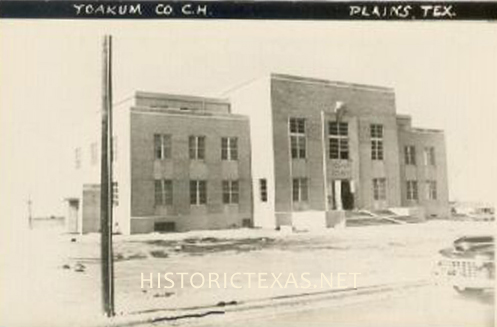
Yoakum County (C-8) is in western Texas on the southern High Plains, along the New Mexico border. The center of the county is at 32°10' north latitude and 102°50' west longitude. Plains, the county's seat of government, is fifty miles southwest of Lubbock. The area was named for Henderson King Yoakum. Yoakum County covers 800 square miles of nearly level terrain composed of sandy soils that support prairie grasses and some mesquite, yucca, shinnery oak, and sandsage. Elevations range from 3,400 to 3,900 feet above sea level. The area is drained by Sulphur Springs Draw, which runs through the center of the county. Temperatures vary from an average minimum of 24° F in January to an average maximum of 92° in July, and annual precipitation averages sixteen inches. The average growing season lasts 200 days. U.S. highways 380 and 82 (east-west) and State Highway 214 (north-south) serve the county.
The area that is now Yoakum County was off the path of most early explorations, but Fray Juan de Salas crossed the region in 1632 on his second visit to the Jumano Indians. Comanche, Cheyenne, and Kiowa tribes made the land their own until buffalo hunters and bone gatherers ventured in after 1870. In 1876 the Texas legislature established Yoakum County from lands formerly assigned to the Bexar District, but in 1890 the United States census found only four people living in the area, and as late as 1900 the county had only twenty-six residents. The economy was entirely dominated by cattle ranching at that time. In 1900 the agricultural census listed only one ranch in the county; 6,200 cattle were reported, but no crops. Sale of state land after 1900 brought an increase in population. Early settlers traveled along Sulphur Springs Draw. In 1905 William Jackson Luna established a store and post office at Plains, and when Yoakum County was organized in 1907, Plains became the county seat. By 1910 there were 107 farms or ranches in the area, and the population had increased to 602. Almost 23,000 cattle were reported that year, but crop farming remained limited. About 3,000 acres were planted in sorghum, the county's biggest crop, and 1,700 acres were planted in corn; only two acres were planted in cotton. The county gained a newspaper in 1910 when Neil H. Bigger began publication of the Yoakum County News. Farmers suffered during the 1910s despite some brief attempts to grow wheat and the start of a flourmill at Bronco in 1915. By 1920 there were 109 ranches or farms in the area, but the population had fallen to 504. More than 21,000 cattle were reported that year, but crop cultivation remained limited; about 2,200 acres were planted in corn, 600 in sorghum, and 47 in cotton. During the 1920s the county experienced a minor expansion of crop farming, and cotton became the most important crop; by 1930 over 10,000 acres were devoted to cotton. There were 239 farms, and the population had increased to 1,263. Substantial economic development began after 1936, when oil was discovered. Intensive production quickly ensued, and in 1938 more than 1,239,000 barrels of crude were produced in the county. The boom centered at Denver City, founded in 1939, and by 1940 the county population had jumped to 5,345. Meanwhile, agriculture declined. By 1940 only 5,000 acres were planted in cotton, and the number of cattle had dropped 10 percent since 1930. Oil production intensified during the 1940s as Yoakum County became one of the leading oil-producing counties in the state. Almost 18,413,000 barrels were produced in 1944, for example, and almost 25,222,000 barrels in 1948. Production dropped to 19,027,000 barrels in 1956 and 13,330,000 barrels in 1963, then jumped to 77,632,000 barrels in 1974. In 1990 more than 32,858,000 barrels of crude were produced in Yoakum County, and by January 1, 1991, almost 1,664,036,000 barrels of oil had been taken from county lands since 1936.
In the decades after World War II irrigation helped to open thousands of new acres to fruitful cultivation. By the mid-1970s over 86,000 acres in the county were irrigated, and farmers grew sorghum, cotton, alfalfa, watermelons, and castor beans. The population of the county fell to 4,339 by 1950, then grew to 8,032 by 1960. There were 7,344 residents in 1970, 8,032 in 1980, and 8,786 in 1990. The voters of Yoakum County supported the Democratic candidate in every presidential election between 1908 and 1956, except in 1928. The Republicans, however, carried the county between 1960 and 1992, except in 1964, when voters supported Democrat Lyndon B. Johnson. In 1982, 93 percent of the land in Yoakum County was in farms and ranches, and 44 percent of the farmland was under cultivation. Some 110,000 acres were irrigated. About 95 percent of agricultural revenue was derived from crops, especially cotton, sorghum, wheat, hay, and corn. The raising of livestock, especially beef cattle, hogs, and sheep, also contributed to the economy. In 1982 more than 471,000,000 cubic feet of gas-well gas, over 28,150,000,000 cubic feet of casinghead gas, and almost 48,440,000 barrels of petroleum were produced in the county. In the mid-1980s the county had two libraries as well as the Tsa Mo Ga museum in Plains, a hospital, two airports, and a rodeo park. By the early 1990s Plains (1990 population: 1,422) remained the county seat, although Denver City (5,145), the county's oil center, was the largest city in the county. The only other towns in the county are Bronco (30) and Allred.
BIBLIOGRAPHY:
Texas Technological College School of Business
Administration, An Economic Survey of Gaines, Terry, and
Yoakum Counties (Lubbock, 1953). Yoakum County Historical
Commission, Yoakum County (Dallas: Taylor, 1985).
John Leffler, "YOAKUM COUNTY," Handbook
of Texas Online
http://www.tshaonline.org/handbook/online/articles/hcy01
Published by the Texas State Historical Association.

